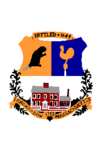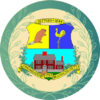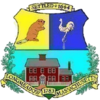Longmeadow, Massachusetts facts for kids
Quick facts for kids
Longmeadow, Massachusetts
|
|||||
|---|---|---|---|---|---|
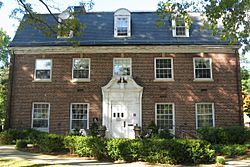
Longmeadow Town Hall
|
|||||
|
|||||
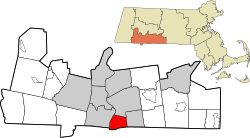
Location in Hampden County in Massachusetts
|
|||||
| Country | United States | ||||
| State | Massachusetts | ||||
| County | Hampden | ||||
| Settled | 1644 | ||||
| Incorporated | 1783 | ||||
| Government | |||||
| • Type | Open town meeting | ||||
| Area | |||||
| • Total | 9.7 sq mi (25.0 km2) | ||||
| • Land | 9.1 sq mi (23.6 km2) | ||||
| • Water | 0.5 sq mi (1.3 km2) | ||||
| Elevation | 160 ft (49 m) | ||||
| Population
(2020)
|
|||||
| • Total | 15,853 | ||||
| • Density | 1,739.8/sq mi (671.74/km2) | ||||
| Time zone | UTC-5 (Eastern) | ||||
| • Summer (DST) | UTC-4 (Eastern) | ||||
| ZIP Code |
01106, 01116
|
||||
| Area code(s) | 413 | ||||
| FIPS code | 25-36300 | ||||
| GNIS feature ID | 0618186 | ||||
Longmeadow is a town in Hampden County, Massachusetts, United States. It's located in the western part of the state. In 2020, about 15,853 people lived there.
Contents
History of Longmeadow
Longmeadow was first settled by people in 1644. It officially became its own town on October 17, 1783. Before that, it was mostly farmland that belonged to the city of Springfield.
For a long time, Longmeadow stayed a quiet, farming area. But around 1910, when a street railway was built, more people started to move in. The town's population grew three times bigger in just 15 years! Later, between 1960 and 1975, the population tripled again after Interstate 91 was built nearby.
Brownstone Mining and East Longmeadow
In the 1800s and early 1900s, Longmeadow was famous for its brownstone. This special type of rock was mined here. Many famous buildings in America, like a library at Princeton University, are made from Longmeadow brownstone. In 1894, the part of town where most of the quarries and people were, called "East Village," became its own separate town: East Longmeadow.
Longmeadow Country Club
The Longmeadow Country Club was designed by a famous golf course architect named Donald Ross in 1922. It was a place where golf equipment made by the Spalding Company was tested. Even the legendary golfer Bobby Jones was a member here and made some of his teaching films at the club in the 1930s.
Geography and Nature
Longmeadow is in western Massachusetts, just south of Springfield. The Connecticut River is on its west side, and it borders Agawam to the west, East Longmeadow to the east, and Enfield, Connecticut to the south. The town is about 3 miles (4.8 km) long from north to south and 4 miles (6.4 km) wide from east to west. It's also about 20 miles (32 km) north of Hartford.
Open Spaces and Wildlife
A lot of Longmeadow, more than 30%, is kept as permanent open space. This means it's natural land that won't be built on. There are over 750 acres (3 km²) of conservation areas along the Connecticut River. These areas are home to many animals like deer, beaver, wild turkeys, foxes, and even eagles!
Springfield's Forest Park, which is the biggest city park in New England, is right on Longmeadow's northern border. It's 735 acres (2.9 km²) big. The town also has two golf courses, athletic fields, and other conservation lands. Almost 20% of the houses in town are near a "dingle." A dingle is a sandy, tree-lined ravine with a wetland at the bottom. They help create privacy between yards.
The Town Green and Shops
Longmeadow has a special area called "The Green," which is a long, historic town common along U.S. Route 5. It's about half a mile long. Many old houses, some from the 1700s and 1800s, are located around The Green. This area is so important that it's listed on the National Register of Historic Places. The Green is unique because it's still mostly residential and hasn't become a big commercial area.
The main shopping area in town is called "The Longmeadow Shops." Here you can find restaurants and clothing stores.
According to the United States Census Bureau, Longmeadow covers a total area of 25.0 square kilometers (9.7 sq mi). Most of this, 23.6 square kilometers (9.1 sq mi), is land, and 1.3 square kilometers (0.5 sq mi), or about 5.34%, is water.
Population Changes
Longmeadow has grown quite a bit over the years. Here's how the population has changed:
| Historical population | |||
|---|---|---|---|
| Census | Pop. | %± | |
| 1850 | 1,252 | — | |
| 1860 | 1,376 | 9.9% | |
| 1870 | 1,342 | −2.5% | |
| 1880 | 1,401 | 4.4% | |
| 1890 | 2,183 | 55.8% | |
| 1900 | 811 | −62.8% | |
| 1910 | 1,084 | 33.7% | |
| 1920 | 2,618 | 141.5% | |
| 1930 | 4,437 | 69.5% | |
| 1940 | 5,790 | 30.5% | |
| 1950 | 6,508 | 12.4% | |
| 1960 | 10,565 | 62.3% | |
| 1970 | 15,630 | 47.9% | |
| 1980 | 16,301 | 4.3% | |
| 1990 | 15,467 | −5.1% | |
| 2000 | 15,633 | 1.1% | |
| 2010 | 15,784 | 1.0% | |
| 2020 | 15,853 | 0.4% | |
| 2022 (est.) | 15,632 | −1.0% | |
| U.S. Decennial Census | |||
In 2000, there were 15,633 people living in Longmeadow. About 37.1% of the households had children under 18 living with them. The median age in town was 43 years old.
Education in Longmeadow
Longmeadow has a great public school system with six schools.
- Elementary Schools: Blueberry Hill School, Center School, and Wolf Swamp Road School teach students from kindergarten to 5th grade.
- Middle Schools: Williams Middle School and Glenbrook Middle School are for grades 6-8.
- High School: Longmeadow High School serves all students from 9th to 12th grade.
The elementary schools have been recently rebuilt. A new high school was built and opened in 2013, costing about $78 million. The town received about $34 million from the state to help with the construction.
Private Schools
Longmeadow also has two private religious schools:
- The Lubavitcher Yeshiva Academy (LYA) was started in 1946. It's a Jewish day school that serves over 90 students each year. LYA was the first Jewish day school to be approved by the New England Association of Schools and Colleges (NEASC).
- St. Mary's Academy is a Catholic school for students from pre-kindergarten through 8th grade.
Music Program Achievements
The music program at Longmeadow High School is very popular, with about half of the students participating.
- The choruses have won many gold medals at the MICCA competition.
- The jazz ensemble has also won many gold medals.
- The honors chorus, "Lyrics," has won awards and traveled to places like Italy and Sweden.
- The wind ensemble and symphony orchestra have performed in famous places like Boston Symphony Hall and Carnegie Hall in New York.
- In 2010, Longmeadow won The American Prize in Orchestral Performance.
- The music program has even received three national Grammy Awards for its high quality!
Longmeadow is also home to the main campus of Bay Path University, which is a private college founded in 1897.
Notable People from Longmeadow
Many interesting people have connections to Longmeadow:
- Terri Alden, fictional nurse
- Barry Almeida, professional hockey player
- Erinn Bartlett, actress (Deep Blue Sea, The In Crowd)
- Mary Ann Booth, microscopist
- Kingman Brewster Jr. (1919–1988), former President of Yale University and Ambassador
- Craig E. Campbell, Alaska's 10th lieutenant governor
- Brynn Cartelli, winner of the 14th season of The Voice
- John Chapman (Johnny Appleseed), pioneer who planted apple trees
- David Cohen (1917–2020), a US Army member and schoolteacher
- J. H. Colton, a leading mapmaker in the 1800s
- Bianca D'Agostino, former soccer player
- John Deluca, actor (Butchy in Teen Beach Movie)
- Damien Fahey, MTV VJ and host of Total Request Live
- Meghann Fahy, actress (Sutton on Freeform's The Bold Type)
- Paul Fenton, Former NHL General Manager
- Jonathan Green, British author and journalist
- Jay Heaps, former player and manager for New England Revolution
- Nathan Cooley Keep, pioneer in dentistry, founding dean of Harvard School of Dental Medicine
- Eric Lesser, former Massachusetts State Senator
- Aaron Lewis, guitarist and vocalist for the band Staind
- Chirlane McCray, writer and activist, wife of former NYC mayor Bill de Blasio
- Bridget Moynahan, model and actress (star of Blue Bloods)
- Joe Philbin, NFL coach
- Joey Santiago, lead guitarist for the band Pixies
- Anita Shreve, award-winning writer
- Jim Sleeper, author and journalist
- Michael Tougias, author and speaker
See also
 In Spanish: Longmeadow (Massachusetts) para niños
In Spanish: Longmeadow (Massachusetts) para niños


